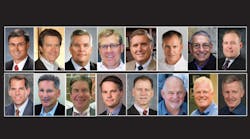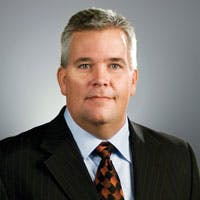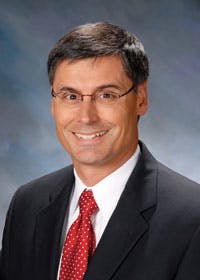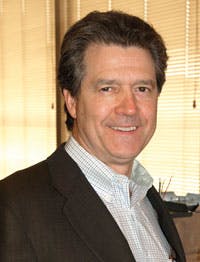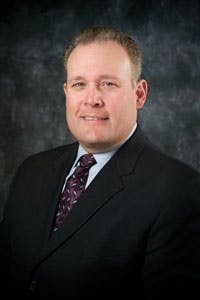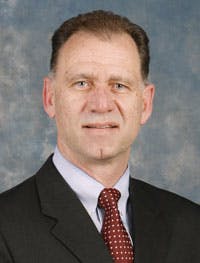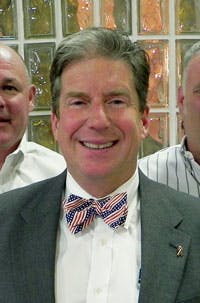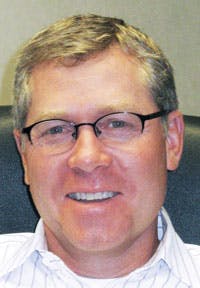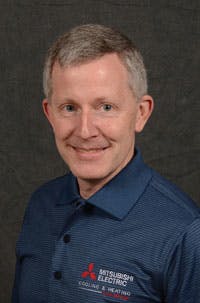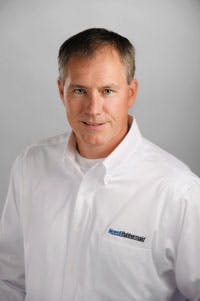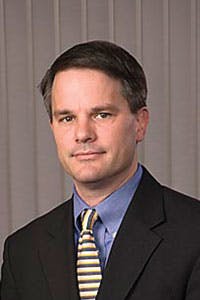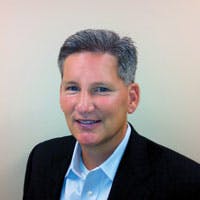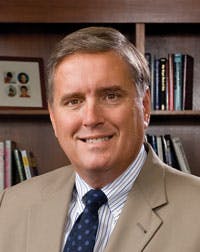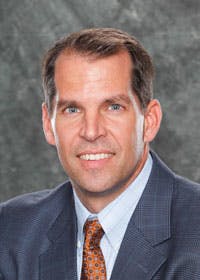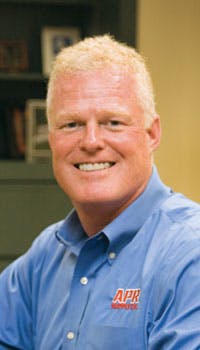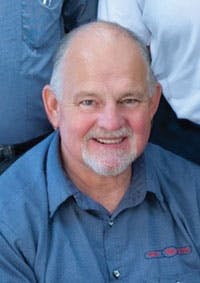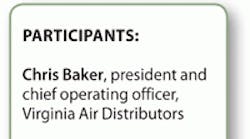Latest from Archive
HVACR INDUSTRY GALLERY OF INNOVATION
Down to Business
Systematizing HVAC Operations
2019 Leaders in HVACR/Hydronics Innovations
Solve Crawlspace Moisture Problems
This year's participants:
• Steve Wright Sr., president, Wright Brothers, Inc., ContractingBusiness.com’s 2013 Refrigeration Contractor of the Year
What overriding mistake(s) do contractors make that hold them back from being as successful as they could be?
Gary Clark: First off, with the mild weather patterns experienced the past couple of years combined with the economic downturn and slow economy, we believe that the majority of HVAC contractors are successful simply by remaining in business. It’s just an example of the strength of independent HVAC dealer/contractors and the HVAC market as a whole. Perhaps one area where dealers typically hold back is within the area of sales lead generation tools. Many dealers profess that word of mouth delivers the greatest number of sales leads for their company. While this is true, a few easy marketing programs in their local community can increase both the word-of-mouth leads and customers that extend beyond the limited range of current customer interactions. HVAC dealers need to embrace fully the power of electronic, mobile and web-based sales lead generating programs. Many dealers have been early adopters of these opportunities, but the majority of dealers still lag behind in this area.
Brian Cobble: Three key success factors for most professional contractors will typically include 1) having a trained, technically competent, trustworthy and courteous staff that understands customer needs; 2) having a good understanding of business fundamentals and what is required to run a profitable operation; and importantly, 3) having an awareness and working knowledge of current and emerging technologies and products that can be of benefit to customers and prospects of the contractor’s business. It’s generally likely that contractors unable to adhere to these basic fundamentals will not have an ability to be as successful in the long run as they otherwise could be.
John Galyen: I certainly would not describe them as mistakes, but rather I see two main challenges facing contractors. First, contractors today are faced with running their business in an uncertain economic environment when new construction and homeowner investment has slowed. Here, it’s important to have a clear business model and value proposition for products and services. The second challenge is staying current on new technologies, codes, standards and regulations by investing in continual training and education.
Jerry Hurwitz: Thanks to my involvement for many years in an Air Conditioning Contractors of America (ACCA) Management Information Exchange (MIX) Group, I have had the opportunity to experience the inner workings of other contracting firms. I have found that all of the members in my group (including me) run their businesses not on pure logic, but in some part, on their emotions.
When the members of my group would go to visit a fellow contractor's site and we would see a blatant policy mistake, such as not charging enough, the host contractor would usually acknowledge the problem. In our discussion with him he would give some rationalization for why he was charging so little, and vow to make a change. Amazingly enough, we would go back and visit five years later and find that he was still under charging for what his service was worth.
But this “mistake” of running in part on our emotions has an upside. Some huge national organizations that have set policies, probably do things in a more uniform logical way and don’t experience the same things that "hold them back" that independent contractors do. However, they generally can't be responsive to unique customer or employee needs and generally cannot provide the same personal touch that independent contractors can. Those of us who run our businesses based on our guts can be very caring to our employees and offer very personalized service to our customers.
We all have a blind side that negatively impacts our businesses. One that comes to mind immediately in my case is not firing certain employees long after they should have been let go.
Some owners take too little risk, some take too much. Some owners can’t delegate and some play too much. Some owners can’t stay focused and are constantly getting into new markets or taking on new cutting edge products. There are many more examples, caused by us making decisions emotionally rather than logically.
Yes, our emotional part of our management styles often costs us money and is observed by outsiders as a mistake, but it is part of the human quality that makes our independent companies unique and attractive to work with.
Hugh Joyce: I think the biggest mistake contractors make is not marketing our business enough, not promoting enough and not working on our branding enough.
David Kesterton: The biggest mistake is getting started (opening their business) with little or no capital. Capital is king, and having adequate capital gives owners many options not afforded to others in this industry. It’s a big hindrance and can hold good contractors back from reaching their potential. If they grow too quickly, they will always be behind the eight-ball without adequate capital. Opportunities such as trade discounts will be missed and will ultimately hurt their chances to grow.
Mark Kuntz: We’d like to see more contractors getting up to speed on new technologies. Of course, our bias would be toward variable-output DX systems — the mini-splits and variable-refrigerant flow systems being classic examples of that — and understanding how these can provide new and better solutions for their customers. I think there’s a tendency for all of us to default to the things we know and are comfortable with, so when we encounter a new opportunity, there’s occasionally the tendency to put a “risk premium” on it. In the case of a contractor, if it’s a product he hasn’t worked with before there’s some uncertainty. And by putting a risk premium on it, it almost becomes a self-fulfilling prophecy: it has the potential to price the project out of the market, and so the default to the conventional is the next step and you never break out of that vicious cycle.
There’s a great example of a group up in the Pacific Northwest called the Ductless Project. This is a consortium of utilities that formed a group to really educate the contractor base on the benefits of ductless for the energy savings potential. We worked with them very closely to do extensive contractor training; several hundred contractors were trained on installation techniques, sizing, selection, it really kind of cleared away that risk premium. People became comfortable that these were products that they could successfully sell. And to date the training, the marketing, and incentives that have been put on the table by this group have resulted in the sale of more than 18,000 ductless systems over the last three years. There are numerous testimonials from contractors on the Northwest Ductless website saying, “This technology and this approach kept our business thriving through the recession and the ensuing days when others around us were withering,” and in many cases they’ve shifted their whole business model.
So by getting familiar, getting trained, and trying some new things they were able to take that risk premium out of the equation and build a new business model.
Rich Mathews: From a manufacturer’s perspective, HVACR contractors can be resistant to change, particularly in terms of the tools they use. Brand loyalty is great, but when contractors continue to use the same instruments from the same manufacturer year-over-year, they may be missing an opportunity to do their job more efficiently — either by maximizing their time on a call by using a dual-purpose tool or using a new tool that helps make a standard repair quicker.
David Meyers: There are many variables that go into being a successful contractor. A few key areas of focus would be:
• Strong business acumen with a thoroughly-developed business plan, as well as a long-term succession plan
• The ability to price/quote work with a full understanding of the margins and profitability for their business
• Being prepared and confident to quote multiple options, including the most efficient and the best overall customized solution so the customer can make an informed decision
• Association with an industry-leading brand that has comprehensive customer service, programs and product platforms.
Chris Peel: The best contractors in the industry don’t make many mistakes. Less successful contractors tend to miss two important opportunities when interacting with customers. The first is the opportunity to establish or build upon a relationship. Effective relationship building brings not only repeat business, but highly valuable positive referrals.
The second is the opportunity to market high-efficiency solutions or new technologies that bring real value to consumers, not to mention higher profitability sales.
There’s a real demand for products that give homeowners energy savings each month. According to the National Association of Realtors’ Profile of Homebuyers and Sellers, 2011, 87% of homebuyers and sellers rated energy efficiency in heating and cooling as “very” or “somewhat” important to their choice of a home.
Contractors are in a prime position to educate consumers on the long-term benefits of higher efficiency solutions. One way that they can help homeowners is to explain the lower annual operating costs for these systems. Manufacturers can provide annual operating cost figures for energy efficient heating, cooling and water heating systems, as well as standard water heating options.
In addition, contractors should share information about federal and local rebates available. For instance, the American Taxpayer Relief Act of 2012 has been extended, which continues tax credits through the end of 2013.
Ed Purvis: The most pressing issue facing contractors today is a familiar one: The workforce is aging, and it lacks the level of technical skills that it will need going forward. So the issues become, how do we bring more of the right type of people into the workforce, and how do we promote being a technician or a contractor as a job that a talented young person should aspire to?
When we look at some of the issues we as a manufacturer face, such as high reliability and maintaining our equipment, having a better contractor force is something that is in our best interest.
At Emerson Climate Technologies, we devote a lot of time and energy training contractors. We have an excellent educational services group, and over the past few years have also invested in developing electronics and diagnostics that help contractors more easily troubleshoot systems. The best example of that is the CoreSense™ compressor electronics that we’ve launched in the past few years that provide system diagnostics. We’re several years into the CoreSense program now, and the data shows that where CoreSense is being applied in systems the result is increased reliability of systems and components. It also makes system maintenance easier and faster to perform.
So training the workforce and providing designs and tools that allow technicians and contractors to more easily to work on systems are our key areas of focus.
As far as mistakes contractors may make, I think the answer lies in training. Many of the components in systems are evolving and improving, and frankly I think contractors need to invest more time to get trained on the new products out there so they can correctly apply them and take advantage of the benefits they offer.
Mark Wagner: As an equipment supplier and partner with residential HVAC contractors, we are well aware of the challenges that face these businesses every day. I would not offer a comment on mistakes, but there are some common improvement opportunities that we try to work closely with our dealers:
• Investing in business training to assist in the transition from technician to business owner as a new residential contractor grows and matures
• Utilizing resources available to them to create a support team to help them navigate the road to success (i.e., banker, insurance agent, accountant, other business owners)
• Building good relationships with their supplier and aligning with their HVAC equipment provider (like Trane) to provide insights, support, sales plans, lead generation, technical training, and more
• Managing their labor force to drive their profitability including service and installations
• Working “on” the business rather than “in” the business
• Embracing innovation in products, sales process and tools, marketing/promotion, and people to differentiate themselves in the marketplace.
Steve Wright: Losing control of cash. When the cash is gone the party is over. Most businesses fail not from a lack of profitability, but because they run out of cash. This easily can happen when you take on more business than your operation is capable of handling or by allowing your receivables to get way behind. I think you need to do a cash projection for 90 days that includes all of your cash income and cash usages for that period, it should be reviewed and adjusted every week or two.
What are you doing to recruit replacements for retiring baby boomers and for other manpower needs? Are you focused on the young and women?
Jerry Hurwitz: Recruiting for replacement of retirees is a two-part question: field replacement and office replacement. Recruiting for the field is not a big problem other than the time it takes to develop new technicians, because we hire tech school grads and train them.
For management positions it’s another story. I believe the best place to find management replacements is from within because people who already work for you understand your company’s culture. This can have a downside; however, because by hiring from within we lose the skills and expertise that may be brought to us by an outside hire.
Hugh Joyce: We are focused on women and younger to middle-aged folks that we can bring in and grow our own excellent worker. We continue to look for anyone that wants a better culture and a better work environment. The real opportunity is bringing women into the business.
Steve Wright: Definitely not by hiring them away from other companies. You must have a good name in the marketplace, and with your wholesalers. To get good people interested in this industry we have started sharing with them the computer and controls side of the business as well as some of the more technical issues we face. We also try to show them a career path.
What new technologies are you excited about and what technologies do you see fading from view?
Michael Albertson: We’re extremely excited about variable-capacity compressor technology and believe it’s the future of high efficiency HVAC. These systems provide far better comfort with far lower energy consumption and operating costs — the top concerns for most homeowners. When you apply that variable-capacity technology to geothermal heat pumps, you really end up with a solution that truly represents the best of the best.
Variable-capacity is unique because rather than running at the one or two speeds of normal compressors, this technology adjusts its speed to match the heating or cooling load of a building exactly. Imagine if your car had only two settings: 30 mph and 70 mph. It would be very strenuous to drive and it probably wouldn’t get very good gas mileage. As we all know, gently accelerating and maintaining constant speeds increases efficiency.
In the same way that dual-stage units have taken over the market since their introduction, variable-speed will have a similar outcome.
Gary Bedard: We’re always attuned to the developments in our core technologies — heat transfer, air movement, motors, refrigerants and the refrigeration cycle. And, we’re actually seeing a number of interesting developments on all of these fronts as we look at new heat transfer materials and declining costs make some technologies feasible for more widespread use. Inverters are certainly one area where we’ve seen changes, allowing better seasonal efficiency while also bringing the promise of greater comfort through capacity modulation. I think one of the most exciting developments is in the area of controls. We’re developing new ways for the different elements in our systems to work together to deliver even greater comfort and efficiency for homeowners.
As for technologies fading from view, I’m not sure that I feel that way. Different technologies meet different price points and market needs. Today’s market needs have a way of shifting suddenly as energy markets, government policy and manufacturing costs shift. And, let’s not forget that our design tools are getting more sophisticated. For example, a few years back the idea that we could make the most efficient furnace out there AND make it among the shortest at the same time would have been counterintuitive. Yet, technology is also changing the design tools that we use, making extremely rigorous modeling possible. The result is even technologies that we thought we understood well can gain new life.
Gary Clark: Any new technology that offers homeowners ease of use for their HVAC system or enhanced energy efficient performance gets our company excited. Inverter technology is coming soon and will offer higher levels of energy efficient performance. Gas furnaces are getting more and more efficient and the heat exchanger designs are generating greater durability than previous designs. Communicating control systems are allowing dealers to install high efficiency systems as easy, or easier, than standard efficiency systems . . . and offer homeowners an incredible array of options. Remote control for the central HVAC system seems very popular with homeowners today. Smaller diameter condensing coil tubing is a new technology too that offers outstanding performance benefits with regard to heat transfer properties of R-410A chlorine free refrigerant. All aluminum evaporator coils are showing impressive resistance to a primary cause of premature copper/aluminum evaporator coils.
Brian Cobble: The potential associated with new and emerging communications technology is something the industry can be excited about. This may take the form of empowering consumers with better and more timely and accessible information using newer, more cost-effective home automation and other related technologies that have been and are being developed (that previously have been more exclusive to commercial and industrial building applications, due to traditionally higher associated cost and complexity). Or, it may be through the use of better communications technology throughout the contractors supply chain, that can bring more timely, convenient, and relevant information to the contractor more quickly and accurately, and bring improved overall efficiency and effectiveness to the entire chain of commerce.
John Galyen: Systems are becoming more intelligent and more complex – and more energy efficient. Greater connectivity, with more sensors and inputs, is an important evolution in HVAC systems.
We’re excited to see growing interest in variable speed technology in commercial and residential applications, including geothermal. While this technology has been available for several years, it has broad benefits for the home or building owner and is a solution for utilities by offering demand response capabilities. It enables precise load matching, reduced energy consumption, and better climate control. We have been leading in this solution, globally, for many years with deep product and application expertise in both the compressor and drive technologies.
On/off or ‘stand alone’ technologies that aren’t part of an integrated system will be replaced by smarter, integrated solutions.
Jerry Hurwitz: We’re excited about ourplan for all of our service techs to have wireless pads that enable them to access records from our office, create invoices, and capture signatures from customers. We think this technology will open many new avenues of customer service and growth for J&J.
On the HVAC equipment side, I think large semi-hermetic compressors are going to be things of the past, like pneumatic controls. We see more and more multiple scroll compressor racks with individual compressors being 15 tons and smaller. When I started in the field we were working on reciprocating compressors as large as 120 horsepower.
Hugh Joyce: I’m very excited about the wireless, remote monitoring, and diagnostics on the systems where it will tell us when it’s broken. What I see dying is gas and oil technology over time.
David Kesterton: The industry is obviously in a transition from single-speed compression technology to inverter/variable-speed technology. The manufacturers, distributors, and dealers who embrace the new technology will ultimately succeed in the coming years.
Fading from view, I think there is still going to be a market for “base standard product.” However, as more and more consumers educate themselves through the internet, higher-tech product will gain share.
Mark Kuntz: The technology I want to mention is one that we’re very excited about, and it’s the idea of the super-insulated building. These sometimes go under the terminology of net-zero or passive house. But it’s the idea of taking a building and squeezing out every ounce of inefficiency and building a really tight envelope, and then what’s left over after you’ve squeezed all the excess energy out of the system you can replace with some type of renewable and in effect you’ve got a building that’s not using any energy on balance.
We saw this as an emerging niche, and because these building are so efficient, it takes extremely different means of looking at the HVAC systems in them. You have to calc it differently, you have to design systems differently, and of course with very low heating and cooling loads a variable capacity system is a really great alternative for them. We’ve just had our first passive house certified in Chicago, it’s a 3,500 sq.ft. house and the entire building is conditioned with two 9,000 Btu mini-splits, just to give you an idea of how radically different that is from what you’d expect. And we’ve seen it grow from a niche to now there’s entire developments of passive houses going in, there’s some states talking about integrating the passive house standard into their building code and transitioning to that over the course of several years, and of course the federal government is really incentivizing the use of net zero on the commercial side, so we see it as a great fit both in terms of eliminating long-term life-cycle cost for the owners and occupants, and providing contractors with a very new approach and new way of looking at how to condition a space and to maximize their skill set and build some expertise in doing it.
Rich Mathews: New technologies such as electronic or digital technologies are really coming into play in the HVACR industry. Used alone or in conjunction with traditional analog methods, technology can help make the job more efficient.
For example, at hilmor we have the Dual Readout Thermometer, which is the industry’s only manifold-compatible compact thermometer with two readings that simplify the calculation of superheat and subcool. In our research, we found that some HVACR technicians don’t fully trust digital yet, so we had that in mind when we developed the Electronic Gauge with Vacuum Sensor, which provides LCD displays for pressures temperatures and calculated superheat and subcool — along with the traditional needle gauges that show system pressure and LSAT/VSAT temperatures.
Also, new technologies surrounding the use of mobile devices continue to grow. We’re finding that technicians use their cell phones, iPads and such to research tools on our web site and to locate a nearby distributor. They also use mobile devices in communications with clients and record keeping.
David Meyers: We are excited about our variable speed compression technology, which is used in the Carrier® Greenspeed™ Intelligence line of adaptable speed heat pumps and furnaces. The technology provides a breakthrough in comfort and efficiency, which provides a great platform to address the changing needs of homeowners. Adaptable speed means a furnace or heat pump with Greenspeed intelligence can run from 40 to 100% capacity — or anywhere in-between — so it adapts to exactly what the home needs for heat, or in the case of the heat pump, for cooling, too. This means the system is smart enough to pick the operating capacity that is most efficient, delivering precise, desired temperatures while saving homeowners money.
Additionally, Carrier’s Captures & Kills™ technology, featured in the Infinity® air purifier, can trap up to 95% of pathogens down to 0.30 micron in size, and works silently in tandem with the HVAC system to make the air a homeowner breathes healthier.
Carrier has also developed products that improve overall indoor air quality – the Performance™ Series Energy Recovery Ventilator (ERV) and the Performance Series Heat Recovery Ventilator (HRV). If a home is in a warm, humid climate, then an efficient ERV would be a great addition. ERVs quietly replace stale indoor air with fresh outside air using the outgoing air to precondition incoming air, which helps keep a system running efficiently. Using specially designed, treated paper cores, they are also able to reduce humidity from the air before it enters your home. If the region typically experiences long winters and shorter, drier summers, an HRV can make sure the indoor air is fresh no matter how deep the snow may be outside.
With many new and exciting technologies on the market, some are fading from view. Basic wall controls are a decreasing trend as more and more homeowners are opting for Wi-Fi enabled smart controls for increased efficiency and remote convenience via our Carrier® Infinity Touch Control.
Chris Peel: Rheem is most excited about technologies that integrate HVAC and water heating systems due to the potential for maximizing energy savings. In less than two years, we’ve introduced two integrated products that provide real energy savings, and unique features and benefits:
In January 2012, Rheem launched the H2AC™ Rooftop Unit featuring eSync™ Integration Technology, which is a commercial system that unites an establishment’s air conditioning and water heating systems. It works by switching over from a refrigerant-to-air system, to a refrigerant-to-water system, when there is a demand for air conditioning and hot water. It can pre-heat a customer’s cold water supply to as much as 125F Fahrenheit, ultimately saving customers about 50% on their monthly water heating expenses, and dramatically improving the efficiency of the air conditioning unit while hot water is being generated.
In April 2013, Rheem launched the new Prestige™ Series Hybrid Electric Heat Pump Water Heater. Instead of heating stored water directly with a conventional electric element, this water heater transfers available heat from the ambient air, intensifies the heat and transfers the heat into the water. The unit has an Energy Factor (EF) of 2.45 — giving it the highest efficiency in its class.
Rheem will continue developing integrated products, and our new systems will also include functionality that arms contractors and homeowners with usable analytics. For instance, the Hybrid Electric Heat Pump Water Heater features the water heater industry’s first-ever full-color, backlit touch-screen control, which provides homeowner service alerts as well as detailed, text-based diagnostic information for the contractor.
Ed Purvis: There’s a lot that’s exciting in controls. As we look forward into the next few years we’re going to find more and more electronics used in system control, and this is going to do a couple of things for contractors. First, electronics provide more rapid diagnostics, and, second, it allows contractors to reduce the failure rates of systems and maintain systems better. So clearly the growth of electronics is very exciting.
Another thing we’re going to be seeing more of in the future is modulation technologies. Several years ago Emerson launched a two-step scroll called UltraTech, and that has been a remarkable success. UltraTech allows OEMs to provide systems that better match the load of the home. That provides better comfort and better efficiency for homeowners. The UltraTech™ scroll has been a very strong part of our growth in the residential market segment. More recently we launched a variable speed scroll compressor, and when you look at the variable-speed application it becomes an even stronger opportunity to provide better cooling performance, better heating performance on heat pump applications, and a very high level of comfort for homeowners. The variable-speed launch has exceeded our expectations as far as feedback from the marketplace, and we’re launching a second-generation product this year that provides even higher efficiency.
On the refrigeration side of the business electronics are rapidly gaining traction there as well, but alternative refrigerants such as CO2 are going to become a bigger trend in the next few years. The refrigeration industry has tended to lead in refrigerant transitions in the past, and we think it will happen here, too. But I think we’re going to see more and more people working on environmentally friendly alternatives in the retail space. CO2 will certainly be one.
New system designs that use less refrigerant will be another trend such as distributed systems and secondary systems. The application of scroll compressors continues to grow in this marketplace as well, as scroll compressors are now available that have higher efficiencies than the semi-hermetics in the marketplace today and have powerful CoreSense diagnostics built into them that provide even higher value to the end-user. Those are a few of the key examples.
Mark Wagner: Connected home solutions to monitor residential HVAC system operation, temperature, setpoints, and energy use while the homeowner is away is an exciting new technology that is available in the marketplace. We are seeing tremendous growth due to the consumer value achieved by our Nexia™ Home Intelligence connected home products and our e-monitor energy management system. Variable-speed compressor technology and the utilization of minisplits and VRF systems for multifamily applications is also a growing technology. We are very excited about our variable speed compressor products that will be launched soon and that will allow homeowners to achieve significant energy efficiency at an affordable cost. Our Trane mini split offering is also showing strong growth among our dealer network and consumers.
The market trend toward lower seer entry-level products based on homeowner affordability continues to drive the marketplace. We are excited about the growth of our Ameristar product line and the recent announcement of our new 13-14 SEER air handler product line. These products allow the homeowner to enjoy the reliability and quality of Trane at lower efficiencies while supporting our “Trane product for every home” brand promise. Trane now has a complete product line from entry level to industry leading high efficiency HVAC equipment.
Steve Wright: The cost of operation with natural refrigerants is much higher. The way we produce power in the U.S. is different than Western Europe. I just don’t know if carbon dioxide is going to continue as a viable option especially in the warmer climates like we have here in the south. I really like CO2 and hope the industry finds a way to make it work effectively.
As for newer technologies I think we’re probably going to see smaller systems, and smaller, more efficient compressors that use much less refrigerant charge. Right now we have smaller variable refrigerant DC compressors that will minimize overall system size. Smaller will become more popular, even smaller than distributed systems that we see now.
What ancillary niches do you see having the biggest impact on the HVAC industry — whole house automation? Wireless controls? Fire protection and security? Something else?
Michael Albertson: Energy management integrated into home automation is another area of growth for residential HVAC. Consumers really like the idea of being able to monitor and control their comfort levels from wherever they’re sitting — whether that’s on the couch or on the flight home. The public is realizing that thermostats don’t have to be an eyesore mounted to the wall if they’re an app on your mobile device or tablet. What’s more, with time-of-day rates and critical-peak pricing becoming a reality at electric utilities around the country, these systems provide an opportunity to really affect your pocketbook in a positive way.
Gary Bedard: We live in a very exciting time. The pace of technological change is really incredible. Moore’s Law, the doubling of computing capacity every 18 months, has been true for nearly the last 60 years. The cumulative effect of this change has been enormous. I’ve already talked about the impact of controls. The fact is, the availability of lots of data will allow us to create better control algorithms to make equipment run longer, cost less to operate, and provide greater comfort. Anything that can reduce a contractor’s labor costs, like wireless, will flourish. Directionally, there will be some convergence in home automation, but to some extent it’s already occurring on a consumer’s smart phone even without complicated systems that draw independently supported systems together like security and HVAC.
If we speak more broadly about the contracting business and technology, let me be clear. The impacts will not be niche or ancillary; they will directly impact the core of all of our businesses. One of the amazing developments is the integration of technology with how we engage socially. Reputations are rapidly becoming much more transparent, and this will fundamentally change how contractors market. Word-of-mouth advertising, always the friend of the quality contractor, will now begin to move at light speed. In the home, expectations for how retail salespeople present solutions will also start to change. We’ll no longer be marketing to groups — it will be individuals. And, after the sale, contractors will begin to look at the individual pieces of equipment that they monitor and communicate with on-line as part of their installed network. As both a manufacturer and a distributor, that changes our world as well. We are investing in the kinds of tools and infrastructure to help us flatten our organization and interact and collaborate with our customers in deeper, faster and more impactful ways.
At Lennox, we have a real sense of urgency about investing and moving in these areas because these changes are not in the future — they’re happening now. It’s impacting both the product side and the service side of the business at the same time. Our customers can also differentiate themselves from their competitors, provide a better customer experience, diagnose and repair more efficiently and ultimately be more successful. It’s truly an exciting time!
Gary Clark: Historically it’s considered a niche in the HVAC world, but indoor air quality (IAQ) components can offer a dealer potential sales growth and provide their customer with many benefits. Unfortunately, the primary trigger for a consumer to enter the HVAC world is the breakdown of the current system. Dealers are often under time constraints to get the old unit functioning again or installing a new component or system so the opportunity for a full discussion of IAQ products isn’t the norm. Most homeowners, when shown the benefits of various IAQ products readily see the value in them, and will purchase. But homeowners cannot purchase an IAQ product or system if the dealer never mentions this option.
Brian Cobble: Ancillary niches that can have a substantial impact on the HVAC industry will be formed around the merging and integration of residential automation systems that have or are becoming more affordable and practical, particularly for new construction applications. This will likely require more collaboration and coordination amongst various contractor segments because of the crossover skills that will be required. It will also require an evolution of those systems to achieve greater standardization over time in what seems now to have been more of a proprietary approach to certain applications.
John Galyen: In the residential market, the ability of the HVAC system to connect to the home network -- enabling whole house automation, wireless and mobile platform control, and link to an increasingly smart grid have a big impact on the HVAC industry. Consumers are accustomed to being connected and having information control whenever and wherever, so it’s natural they want to control their home environment remotely. At the current pace of communication and connectivity, we can expect to see continuous development with opportunities for manufacturers, contractors and homeowners.
Jerry Hurwitz: Wireless controls.
Hugh Joyce: Wireless automation.
David Kesterton: All of the above. Generally speaking, our industry is slow to adapt. The whole-house connectivity/automation sector will slowly grow and depend on third-party groups and forward-thinking manufacturers and distributors to push this segment along. Ultimately, an educated consumer will help “pull” the product through, but measureable growth will depend on how quickly dealers embrace these changes.
Mark Kuntz: In keeping with the super-efficient building concept, we are also advancing the notion of being able to deploy heat pumps in very cold climates. And this goes against the way people think about heat pumps, but the technology has advanced to the point where you can develop useful heat from a heat pump at temperatures as low as -13F and do it at coefficients of performance COPs approaching 2. So even at -13F we’re twice as efficient as a conventional strip heater, and this is facilitating the move to all-electric systems in these super-efficient buildings.
It’s a technology that’s little-known, it’s emerging, and it’s providing a whole bunch of solutions to contractors who now don’t have to worry about back-up systems, and integrating controls to control back-up systems, whether they be electric or fossil-fired.
The second area we’re pretty excited about is something called augmented reality. It’s a technology we’ve pioneered in our factory settings, where a virtual image is superimposed against an actual environment. You can do it photographically or even with glasses that you wear. In the factory environment, it enables a smart system to detect if you’re about to make a wrong move with regard to the assembly of a product. It shows you a virtual image of where the part you’re about to install goes, and as you put it in place it’s confirming that you’re doing it right. Of course that’s a tremendous boon in a factory environment for quality and improvement of a process.
We see this moving out into the field, which of course is a much more complex and uncertain environment but where the benefit could be even greater. Where a technician or an installer actually gets a visual cue of where the part is he’s trying to put in or replace. And instead of having to read through a manual, this actually walks him through the process of removing the damaged part, installing the new part, warning him if he’s doing any aspect of that incorrectly, and then confirming once it’s in place that it’s operating properly. We see this as tremendous aid in the speed with which technicians can diagnose problems, fix problems, and confirm that their diagnosis was correct. And we see it as having applications all over the place, from a homeowner being able to see what a new system would look like in their house, to the installer being able to visualize how best to install and route the system, to the technician who is servicing it and gets step-by-step guidance in how to do that exactly as the factory intended. It really brings that controlled environment of the factory out to the installed base.
We’re at the very baby steps of this. We have a system right now that would allow the homeowner to see how the system would look in their house, and we’re moving that into the servicing area. That’s our next phase.
David Meyers: The shift from HVAC system efficiency to whole home energy efficiency is a trend that has been gaining momentum over the past few years and one that is expected to have a potentially large impact on the industry. The recent proliferation of smart meters, an increased household broadband penetration and the explosion of smart devices has created a growing opportunity for consumers to become more engaged with their energy consumption and management. This engagement will drive consumers to think more holistically, moving beyond their standard HVAC system efficiency and thinking about whole-home efficiency.
Chris Peel: The potential for energy management and water conservation systems is huge. Presently, heating, cooling and water heating systems account for 60% of a home’s energy consumption (according to the ENERGY STAR program). Our products that integrate HVAC and water heating technologies have proven their ability to save energy and money. But, that’s just the first step. To deliver even more efficient products, we have to create technology that connects these systems and then provides valuable analytics to help homeowners better manage their energy and water consumption.
Rheem is laying the groundwork for future connectivity that will bridge across our HVAC, water heating, pool and spa heating product lines through our EcoNet™ controls platform. At the heart of the EcoNet system is a new user interface that allows monitoring and controlling of Rheem’s air conditioning, heating, water heating, and pool heating systems from a single access point, or remotely via smartphone/tablet apps. It will ensure optimal performance and energy savings for homeowners, while simplifying installation, maintenance and troubleshooting for contractors. Additionally, EcoNet is future-compatible with home automation, energy management and demand-response systems. Our recently launched Prestige Series Hybrid Heat Pump Water Heater and new gas furnaces are EcoNet-ready.
Ed Purvis: Facility management. The whole discussion of smart home is probably as old as I am in the industry. There has been a lot of discussion about how that will evolve. Not unlike many other industries, the adoption rate of advanced home technologies has been slow. At the same time, in the past few years there have been some important steps made in technology that we believe are going to drive faster adoption of connected homes and increase the ability to remotely manage both a residential home or a retail facility. Certainly Wi-Fi capability and reliability has driven a lot of that. But another vital factor is the ability to now build very cost-effective cloud architectures by which we can remotely manage lots of data which allows us to optimize the reliability and efficiency of all types of facilities. So what we’re going to see is more focus on enabling technologies such as distributed controls, wireless thermostats, and remote monitoring capabilities.
In my home my stereo system is completely wireless and I control it through my iPhone or iPad. That’s a technology that probably wasn’t ready two or three years ago because the infrastructure wasn’t there, but it’s ready now. We’re going to see similar technology being applied in the HVAC industry in the very near future.
This year we’re launching a “next generation” Wi-Fi thermostat. Initially this product will give homeowners basic capabilities for managing their homes more effectively, but over time those capabilities will become much more sophisticated in terms of remotely making decisions about how people want their home to operate. We have business models that we’re developing and launching with contractors to allow homeowners to remotely track the performance of their home comfort systems and dispatch contractors if there are issues with a home’s heating and cooling system. This type of connected solution is now becoming much more feasible, and in the next three to five years we’re going to see much more of that in homes.
In my own home, I have a pilot system of a new technology that will allow contractors and homeowners to track residential air conditioning and heating systems. I had these sensors installed recently and very shortly after they were installed, a heating problem was detected and an alert remotely sent to our monitoring service — specifically, my inducer fan and limit switch had failed to start on the heating cycle. I would never have known this until my wife woke up in the middle of the night cold! Instead, I had the fan and switch replaced and was quickly up and running with no downtime.
These capabilities are not technical challenges, they’re simply business model challenges: how to provide these capabilities in a way that everyone in the channel recognizes the value, is educated on how to deliver the value, and prepared to support the business models that emerge. That’s the only issue.
The reason this type of implementation hasn’t happened faster has less to do with equipment technology and capabilities and a lot more to do with connectivity of homes. To the credit of the Wi-Fi world, the reliability of connectivity in the past two or three years has dramatically improved. And that’s why we’ve seen many product and business models built around Wi-Fi starting to emerge. It’s a reliable platform now.
Mark Wagner: We are very excited about connected home solutions and home automation. Our research has shown that 84% of consumers want to be connected to their homes via their smart phone while they are away and we have industry leading Nexia products to support that need. Fully communicating equipment is another niche that is growing as the technology becomes more readily available and affordable. Equipment that can run self-diagnostics and send text messages to homeowners or servicers will be a growing future trend.
How do you see health care reform impacting your business?
Brian Cobble: Government health care legislation is creating an environment of confusion, uncertainty and unrest in the HVAC industry, along with other industries, and will likely continue to do so for some time to come (which perhaps was an objective of the legislation?). The navigation through the myriad of regulations associated with the legislation that will be required, along with the corresponding administrative burden associated with it, will also increase the cost of doing business, for individuals and businesses. Likely many businesses will have to make a decision to simply opt-out (which perhaps may be another objective of the legislation?), or modify their hiring and staffing behavior to involve more of a part-time structure. This will eventually move more and more individuals and families away from employer-provided health coverage, to the government-facilitated insurance exchanges, which in turn is likely to result in the evolution of a single-payer healthcare system in this country. Inevitably the system will increase taxes and costs for everyone, most especially working individuals, families, and businesses.
Jerry Hurwitz: Because we have had health insurance for years we have not seen any impact so far. I suspect that we are going to see increases in premiums in the near future, but have seen up to 30% in one year in the years past. So what else is new?
Scott Weaver: It’s a little murky at this time but ultimately the impact of Obamacare is simply going to have healthcare cost more in the United States. And businesses will have to endure an increased portion of those costs.
What is the main challenge facing business today? Would you have given the same answer 5 years ago?
Gary Clark: Everyone has less time today and is more connected electronically than ever before, and this trend will continue. Dealers need to be aware that homeowners are searching for information regarding HVAC systems, HVAC manufacturers, and the dealers themselves in greater frequency than possible prior to mobile communication devices and the Internet. HVAC dealers need to be easy to find and have a great story to tell about their company and services both on the Internet and social media services. The rapid increase of electronic and Internet based media requires greater effort by dealers than when the choices for lead generation tools was simply a decision between print or broadcast media outlets. Five year ago, I would not have given this answer.
Brian Cobble: The primary challenge to businesses today is undoubtedly government influence, intervention, and interference in virtually every aspect of business. In reality, there is probably not now any function or process in business that is left untouched by one or more components of government regulation. In many instances, including within our industry, the involvement of government creates significant uncertainty and/or disruption in the normal stream of commerce, and in the introduction of new products and services. What seemed to be guided much more by an “invisible-hand,” and the natural forces of supply and demand in a freer market environment, is now heavily influenced by lobbying and the very visible hand of government — changing the dynamics in business radically. This answer perhaps would not have been the same one given five years ago, but the writing was on the wall then, and appears to be coming to fruition today.
John Galyen: Managing business in an environment of exceptional uncertainty and complexity is a tremendous challenge. Today, contractors and manufacturers alike are facing an unstable economy, government regulation, and a patchwork of refrigerants combined with a shortage of skilled contractors. While the contractor skills gap and a declining workforce have been long-standing industry issues, it’s my perception that we have been losing ground on both fronts. Five years ago we were just in front of the “great recession,” so although we didn’t have the economic uncertainty, the shortage of skilled contractors was a problem for the industry.
Jerry Hurwitz: The challenge is the same that it always has been: good competitors, and our keeping our eyes on the ball! I don’t think that the government policies at this time have any impact on my business’ future because legislation keeps us all on the same level playing field.
Hugh Joyce: No, I wouldn’t have given the same answer five years ago. The biggest challenge is government regulation, government rules, and bad government policy. If we had that out of the way, there would be great opportunities — not for just heating and cooling but for most American businesses.
David Kesterton: On a contractor level, capital is still a very big challenge. From an industry point of view, navigating between regulation changes, environmental concerns, and technological product changes are all big challenges.
Mark Kuntz: We have new technologies that cut against people’s expectation of what you can do with a heating and air conditioning system. The challenge is making them aware and getting that message communicated when there are so many distractions in our environment. And that’s true not only from a manufacturer’s standpoint but also from a contractor’s standpoint. Today there are an almost infinite number of ways that you can attempt to reach the customer, be it conventional means such as TV and radio or the new social media means such as Facebook and Linkedin. It’s a huge challenge to come up with the formula that gets people to sit up and pay attention, and then moves them to action. And we’re working hard to clarify and unify our message to the marketplace, tying that in with what out Diamond Contractors and our contracting base is doing, having a message that really gets the homeowner or the building owner interested in looking at a new technology and trying to do things differently.
Is that the same as five years ago? Many of these new technologies didn’t even exist five years ago so we’re really working to integrate as many of those into a unified message and work with our contractors to generate interest.
Rich Mathews: A big challenge facing HVACR businesses today is the workforce shortage. It seems like fewer people are choosing to make a career in this industry and I believe other skilled labor industries are facing this same dilemma. Those of us in this industry have a responsibility to encourage careers in HVACR. One way hilmor is doing this is through a scholarship contest that will provide financial assistance to those pursuing education for a career in HVACR. Additionally, our RETOOL representatives are making visits to trade schools to not only demonstrate our tools, but to discuss all the different career paths — from technicians to distributors to manufacturers — available to someone with solid HVACR training and skills.
David Meyers: Change! If we look back five years, we would have just come off of the 2006 DOE efficiency standard change from 10 to 13 SEER, obsoleting more than 80% of industry products overnight. This was followed by significant economic turmoil, where we saw industry shipments cut in half. Then came the American Recovery and Reinvestment Act tax credits that created a massive mix shift in 2009/2010, which was followed by the 2010 phase-out of R-22 and finally, the end of tax credits in 2011. And today, we are in the process of dealing with the change in regional standards.
Chris Peel: Rheem is unique in that we manufacture both HVAC and water heating equipment. Both of these industries have been faced with sweeping regulation over the past four to five years. The number of rulemakings that the U.S. Department of Energy (DOE) and other regulatory bodies have issued to manufacturers has spiked dramatically. What’s been especially challenging is to see a number of rules get started, stopped, delayed and sometimes never finalized. It’s difficult to plan and invest for future product development when there’s so much uncertainty about the industry’s regulatory environment.
On the HVAC side, we’ve seen how uncertainty can cause great concern with regulations such as the implementation of regional standards and the enforcement rules for regional standards. When issues like these are not settled in a timely manner, it puts manufacturers in limbo trying to figure out where we need to invest our resources. We also can’t give an accurate perspective to our customers about how these regulations will impact their business when there’s so much uncertainty.
We’re in a similar quandary on the water heating side. In 2015, new EF standards go into effect as part of National Appliance Energy Conservation Act (NAECA). However, the DOE is also in the process of recommending new test procedures for residential water heaters, which would require uniform test procedures to determine the efficiency of water heaters. It is crucial that the industry and DOE reach an agreement on the test procedures as soon as possible so that manufacturers can have enough time to test and validate products before 2015 NAECA deadline.
Rheem believes that the regulatory environment will remain intense for years to come, and we can expect to see more regulation in our industry, not less. Therefore, it will be imperative that manufacturers, distributors and contractors initiate open dialogues about the real-world impact of proposed rules and the uncertainty that can accompany any new regulations.
Ed Purvis: In one word, the main challenge facing our business is growth. If you look at a kind of “scorecard” for us over the last five years, in areas such as technology implementation, operational performance, developing world-class plants, and globalization of our business, we have had a great run. I often remind my team of this, reflect back and show them the dramatic changes that have occurred in our business. In my biased opinion, their performance has been nothing short of spectacular. But we haven’t grown as fast as we need to.
The unitary market was over 9 million units in 2005, and while we have seen a slow recovery over the last few years we will only reach about 6.4 million units shipped in 2013, based on our current projections. Europe is a mess, has been for the past three years, and probably will be for two more years. At the end of the day our challenge is to navigate around and through those issues and to find ways to grow. Certainly we have done some very good things related to growing in adjacent markets such as industrial refrigeration, and electronics. Those are good things, and frankly, they have met or exceeded our expectations. But they just haven’t been enough. The game is growth.
Would I have done something differently over the past five years? In terms of making the sometimes painful investments in electronics and facility management/business model investments, and all the investments associated with globalization, I think I would have done everything the same. I would probably do a little better job of calibrating the expectations of me and my team on the time and effort required to execute on these initiatives.
If I could have done one thing differently I think we would have tried to execute faster. Every business faces risk/reward decisions as far as how fast to go forward. We have traditionally been a conservative company and that has served us well for many years, but I wish we had done some things faster, especially in emerging markets. There are several examples where we consciously elected to focus in certain areas, such as India and China, in lieu of other regions. Given what we know now I think I might have also taken a little more aggressive strategy in some of our vertical markets investments, and in some of our international markets in terms of investing faster in the people we needed to grow.
We’ve grown; our operation performance has been very good, and I would say although we haven’t grown as fast as we would like, in my opinion we get a solid “A” in terms of doing the right things in the past five years to position ourselves for the next five years. I think that’s the most important part of that question.
Mark Wagner: A main challenge is to keep up with the ever-changing consumer demands. The current economic pressures in the U.S. have changed homeowner confidence, spending, long-term vs. short-term prioritization, etc. that continues to greatly affect our industry. Government efficiency standards continue to reshape product refrigerant and efficiency standards. This is nothing new, but the 80% furnace regulations, lawsuit, and countersuits were new for our industry and are greatly impacting our inventory decisions, production levels, and which products our dealers promote. For the past five years, finding, attracting and retaining qualified personnel remains a huge challenge for many industries.
What are you actively doing to support contractor certifications?
Michael Albertson: More so than many other segments of HVAC, training is critical to the success of the geothermal industry — and WaterFurnace takes it very seriously. With adoption levels growing every year, we absolutely must prepare contractors to properly design and install geothermal systems. Each bad installation gives the entire industry a black eye because people tend to blame the technology when it’s often problems with installation. The good news is that improper installations are avoidable through training and support.
Every one of our dealers receives an extremely thorough education from some of the best trainers in the industry. Our classes qualify contractors for International Ground Source Heat Pump Association (IGSHPA) Accredited Installer status and are also approved for North American Technician Excellence (NATE) continuing education credits.
After training, we support our dealers with 24/7 access to tech support from staff here at the factory. Problems don’t always happen during business hours so we make sure help is available for whenever they do, and I can tell you our customers appreciate it.
Gary Bedard: Certifications deliver credible third party confirmation of an individual’s mastery of HVAC skills. As a board member of NATE, I am personally a big supporter of the efforts to enhance the professionalism of our industry through certifications. We believe that the best way we can support this is by making top-notch training available to our contractor customers, and investing in our training capabilities. Lennox offers a variety of technical classes from local, product specific classes to national or resident classes designed to take a novice and turn them into a NATE qualified technician. Our customers consistently tell us that having a pathway for non-industry people to become qualified technicians is very important. The downside is that it’s been pretty expensive. But, technology is changing this as well.
In January of this year, Lennox introduced a brand-new Learning Management System that allows our customers and their employees to access a broad library of on-line course work through our on-line DaveNet contractor portal. We’ve also built specific learning paths that guide people to take certain courses in order. The best thing about this system is that it allows the owners of the company to track which courses the employees have taken. And, we’re working with NATE to see if we can automatically upload these courses to register the continuing education credits. This can fill a major gap that both owners and technicians find with the NATE recertification process. Using our Learning Management System, our HVAC Learning Solutions team has just begun an on-line version of their well-regarded “BuildATech” program which we’re calling “Virtual BuildATech.” This allows contractors to take a new employee and bring them from zero to NATE-certified over a four to six month period with very little time away from the contractor’s business.
Gary Clark: Our organization fully supports contractor certification programs such as NATE and others. Our CEO is a member of the board of NATE. We offer training and testing at many of our company-operated and independent distributor locations. Further, many of our distributors have programs allowing a dealer to receive reimbursement for training classes and testing. We promote our support of certification programs on many marketing materials including print and electronic platforms.
Brian Cobble: Involvement with the NATE program is perhaps the most significant approach to encouraging and supporting contractor certification and professionalization in HVAC contracting. There may also be significant temptation to attempt to erect greater “barriers-to-entry” within the industry through legislative “certification,” but such an approach will likely drive up costs to consumers and reduce consumer choice, as competition is reduced due to higher costs of compliance to the smaller business people. This may or may not represent a favorable outcome for the industry. Voluntary certification, coupled with effective marketing to target markets, perhaps being the better alternative.
John Galyen: Training and certification are critical industry issues, and we are continually investing in programs ranging from field, classroom, e-learning and self-learning modules. We support NATE certification.
Our Motion Control University offers International Association for Continuing Education and Training (IACET) certification and continuing education credits. We also conduct a cross-country roadshow that offers one-day technical training seminars for contractors.
David Kesterton: NATE certification is very good for our industry and helps set a standard in the field the consumer can trust and rely on. I think we all need to be more vocal and talk NATE certification in all of our advertising. The more contractors on board with NATE the better. At Mingledorff’s, we set goals and measure our progress towards technician certifications per year. Our FAD (Factory Authorized Dealer) program plays a big role in building our base of NATE-certified technicians.
Mark Kuntz: We’re huge believers in contractor certification. We built the entire ductless market on the premise that our first step has to be to train contractors. We have five centers around the country with live equipment that operate continuously in the process of training and certifying contractors. We are complete believers in that as a necessity and continue to invest to make it happen.
David Meyers: Carrier has a number of programs in place that support contractor education and certifications.
Carrier University is a premier learning organization in the HVAC industry, offering comprehensive HVAC training in a wide range of areas including technical skills, sales and marketing, business management, customer service, controls, design and sustainable building solutions. We offer training for architects, building owners, consulting/specifying engineers, contractors, developers, facility managers and HVAC instructors.
Carrier Factory Authorized Dealers must perform to rigorous national standards, consistently and continually, in order to qualify for our factory endorsement. Additionally, they participate in extensive factory training on technical aspects of equipment installation, maintenance and repair. Factory Authorized Dealers send their sales representatives to Carrier University classes, where they learn to efficiently identify and recommend solutions that provide excellent comfort and value specific to a homeowner’s needs, while incorporating products that are energy efficient, reliable, quiet and environmentally sound.
In addition, Carrier Factory Authorized Dealers are required to employ NATE-certified technicians, who have passed a stringent set of core and specialty exams to ensure their technical competency. They also receive ongoing training specific to Carrier technology and products. Factory Authorized Dealers are also certified by the Environmental Protection Agency for proper refrigerant handling.
Chris Peel: Our training teams continue to work alongside NATE to help expand its reach and impact. We allow several Rheem Academy courses to qualify for NATE credit to help promote NATE certification and technical excellence. Plus, Rheem actively participates on the NATE Technical Committee in developing and refining the certification exams.
In addition, we actively promote NATE- certified contractors on our dealer locator through Rheem.com, so we can drive leads to them. NATE certification is also a key criterion to qualify as an Elite Rheem Contractor (Rheem Team). These contractors have access to several resources to help them grow their business, such as ad kits and marketing materials, co-op programs, partnership programs and more.
Ed Purvis: I’ve served on the board of NATE for a number of years, and Emerson has been investing heavily in NATE both financially and in terms of human resources. I firmly believe technician certification is essential to not only get the number of technicians we need in the future, but also to get the right level of technicians.
The challenge of doing that is having very robust and easy-to-use tools for technicians to get trained, tested, to maintain their certifications, and in the last year or two NATE has made great strides in making the whole certification process more customer-friendly. As I look over the next four or five years, we are going to continue to invest in NATE. The number of certified contractors has grown over the past several years — and we think will continue to grow — and that’s going to be a key part of having the portfolio of contractors we need to drive new products and achieve our goals of bringing new technologies to the marketplace.
Mark Wagner: Trane continues to work closely with our residential HVAC dealers to provide technical hands on training and support utilizing all applicable national and local codes and certifications.
Scott Weaver: On the HVAC side we are proponents of NATE certification. In terms of contractor education, we did about 90 contracting seminars in-house at APR Supply for the contractors last year. We offer continuous training and continuing education.
What are you doing about DIY/online HVAC equipment sales issues?
Michael Albertson: We require each dealership to have someone complete training on our variable capacity 7 Series equipment before they’re even allowed to purchase it. This helps ensure our customers are fully equipped to exceed consumer expectations and think it reflects the dedication levels of a WaterFurnace dealer. It also helps eliminates the market for DIY installations and online purchases of new WaterFurnace equipment.
Gary Bedard: Technology brings both new opportunities and presents new challenges. Online commerce is important, and we recognize that many companies will find innovative ways to grow their business using the Internet. We manufacture an applied product. As good as Lennox products are, proper installation and service is vital for a product that can last 15-20 years or longer. Some of the online business models we’ve seen do not include installation, which could create an issue. The homeowner, the brand, and the industry in general are better served when a product that requires professional installation is in fact installed by a qualified HVAC technician, not essentially drop-shipped to a homeowner. Our terms and conditions of sale require that those who purchase our products resell them with professional installation included. The sold price must include installation. When sales, including Internet sales, do not include professional installation, this in violation of the terms and things like warranty coverage are void. We try to keep abreast of what we see out in the market and handle violations directly as they come up.
Gary Clark: We do not support DIY online purchases of HVAC equipment. We clearly state that the warranty on any equipment purchased on the Internet, from someone other than the installing dealer, is not valid. HVAC equipment must be installed by qualified personnel. That’s why many states license HVAC contractors.
John Galyen: We continue to support traditional distribution channels instead of DIY or online sales channels because we recognize the role trained reps and wholesalers play in delivering value to the contractors, but we work with our channel partners to develop the tools and systems to needed to support their customers.
David Kesterton: Online HVAC purchases/sales have many issues. There are safety, installation, and operation issues, among many others. This is not a simple business and we believe to ensure a consumer receives the best installation they should buy from a local dealer who will stand behind their work.
Mark Kuntz: It’s a serious problem for us. In many parts of the world it’s the norm for a consumer to go to a retail store, pick a ductless system up, put it in their shopping cart, and walk out the door with it. And who knows what they do to get it installed. There are any number of retailers who would like to do that with us here to whom we say no. We turn down those kind of opportunities all the time. That’s not our model, that’s not the way we believe the consumer is best served. We believe they’re best served by a professional installation by a licensed and certified contractor.
We have a great program going on with Home Depot, where a consumer can see a system or a demo or model of the system in person, but the next step is to get a certified professional out to size it, price it, and ultimately install it. That’s the model we are going forward with. Online sales or DIY sales directly to the consumer are not part of our program.
David Meyers: Carrier does not endorse the sale of our products online, direct to consumers. We sell our products through a trained dealer network supported by an experienced distribution organization.
In addition to regular HVAC training, Carrier takes our commitment to supporting contractors even further with our Carrier Energy Experts program. Unlike other energy auditing companies, these experts’ knowledge goes far deeper than insulation and windows. The Energy Experts know the ins and outs of the entire HVAC system — including the air conditioner, furnace and ductwork. They know about whole-home performance from the floorboards to the roof shingles, and every inch in between. The extensive high-level training that Carrier Energy Experts receive enables them to provide Carrier 360° home evaluations using state-of-the-art home performance technology, which can ultimately help homeowners feel more comfortable in their home, while lowering energy bills and even improving air quality.
Chris Peel: Rheem supports the “traditional” business model for the sale of Rheem HVAC products to consumers, in which a trained and licensed HVAC contractor makes sales directly through a personal home inspection and onsite evaluation of the HVAC application. We have a section on our website for consumers that explains why HVAC products are unlike most other consumer goods available for sale on the Internet; this section notes the significance of a site visit by a trained contractor. We emphasize that an in-person home visit by a professional contractor is the only way consumers can ensure they purchase safe and efficient equipment that will last for a long time. We also let consumers know that Rheem published warranties are not applicable for any HVAC equipment manufactured by Rheem that has been sold direct to the consumer via the Internet or auction websites.
Ed Purvis: The industry has been trying to deal with a very challenging set of competitive channel dynamics for a number of years. For a while it had more to do with professional channels vs. retail channels. When you look over the last five or 10 years and try to see what happened there, I think the conclusion has been that the retail channel has played a role, but I bet if you asked some of the OEMs, it has not gone as fast as they would have thought, and the professional channel has managed to continue to remain strong.
In my opinion, it’s because the professional channels — HVAC distributors and strong contractors — continue to offer a value that the retail channel has not been able to duplicate. What about do-it-yourself, or online? I think the same set of parameters will play out. There will be a competition between the professional channel and the value it can deliver, versus the do-it-yourself and online channel and the value it delivers.
For certain products, certain components, we’ll likely see some robust growth in online and do-it-yourself, driven primarily by using electronics to make it easy for homeowners to do some of this work on their own. The best example I can think of is thermostats. In five or 10 years you’ll see easier-to-install thermostats with built-in “app” ability to make it easier for homeowners to install. But I would not forecast that you’re going to see the demise of the professional channel. This industry is and will remain an “applied” industry model. These products must be properly installed and properly maintained in order for them to work that way they should. As long as that’s the model, the professional channel is going to play a key role. Although the do-it-yourself/online channel will grow in selected instances, you’re not going to see a massive switch.
I think the answer is, “Game on.” Distributors and contractors both add value to the professional channel, and contractors who use that value to optimize the homeowner’s experience will have enriched relationships with customers that allow them to grow.
Mark Wagner: Trane dealers have the exclusive rights to provide and install Trane HVAC equipment to homeowners and we do not offer these products through other channels. Some of our connected home products are much better suited for the computer savvy and DIY consumer groups and we offer these products through dealers and on the internet.
Scott Weaver: It’s certainly a new channel for potential competition. We’re encouraging manufacturers to come up with an Internet policy, and adhering to those policies. Right now the policy says if you buy the product online, the manufacturers warranty is void. Policies like that are helping to drive the business through the channel that also includes the services of a professional contractor.
HARDI reports that distributor sales are up. Do you feel that in your market area? If so, what do you attribute it to — pent-up demand, increased new construction, increased service needs, or something else?
Brian Cobble: In our markets there has been meaningful improvement in topline growth. This is a result of a combination of factors. One such factor is a moderate improvement in consumer confidence and slightly improved access to credit, which seems to have resulted in some release in pent-up demand. In addition, in select markets there has been improvement in commercial and residential construction, particularly in areas where the speed at which the inventory of foreclosed homes and buildings has been allowed to drawdown expeditiously, and where access to credit has been improved. There still remains a pronounced “fix-it/repair” mentality that appears to be driven by consumers who are still somewhat hunkered-down, whether due to uncertainty relating to their employment situation, or the current or pending impact higher taxes (including those relating to healthcare) will have on their capacity and ability to spend discretionally.
Jerry Hurwitz: We’re fortunate to be in Silicon Valley. This part of our country is booming and we expect business to be up modestly in next two years at least.
David Kesterton: Our first quarter numbers have improved over last year. I think the economy is stronger than Q1 2012 because of increased new construction and some pent-up demand. We are finding more consumers pulling the trigger on replacements opposed to repairing as they have done for the past five years. In addition, commercial has picked up and shows continued signs of growth. Finally, I think the offering of new products and growing consumer awareness of these new products is helping enhance sales.
Scott Weaver: Yes, distributor sales are up in our marketplace and we’re participating. Different markets are increasing different equipment in our marketplace. Like equipment sales are soft in our market place because we had a flood in late 2011 that pulled units into late 2011 and the first half of 2012, so they were replaced a year ago and don’t need to be replaced. So equipment sales are not great right now. Other markets are doing well like commercial and residential new construction.
In the intermediate to long-term basis, we are very optimistic about the markets — the most optimistic since 2007.








